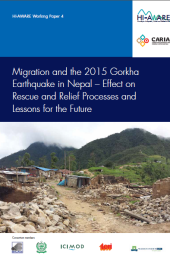Migration and the 2015 Gorkha Earthquake in Nepal; Effect on Rescue and Relief Processes and Lessons for the Future
Summary
The report is about a study in earthquake-affected districts that found migration had mixed effects post-disaster. Right after the earthquake, migrant households were more vulnerable due to a shortage of able-bodied individuals. During relief efforts, migrant households faced obstacles in accessing government support due to lost legal documents. Non-governmental aid was challenging for them as well. However, communities with high migration managed to address these issues collectively. Migrant social networks played a crucial role in accessing relief support, and in the medium to long term, migration and remittances helped reduce vulnerability and aid in recovery.
Categories:
Report
Publisher:
HI-AWARE
Published Year:
2016
